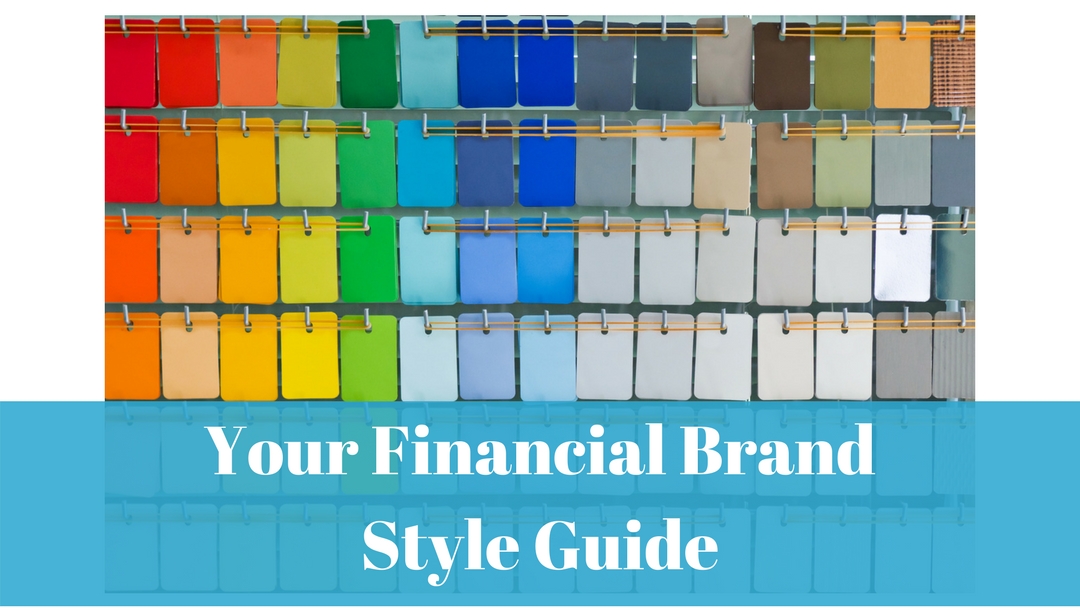What it is, Why it’s needed and How to do it.
WHAT IS A FINANCIAL BRAND STYLE GUIDE?
Your brand style guide is set of prescribed rules to follow whenever anything about you or your firm is created to ensure your audience sees and hears about you and your firm in a consistent, well defined way. Your brand style guide can range from a few pages just describing your logo and colors to a hundred pages with detailed explanations about sizes, fonts, typefaces, presentation in different mediums, imagery, texture, feel and even emotional connection to your brand.
An effective brand style guide should not only outline what is permitted but also what is not permitted when communicating your brand.
WHY A BRAND STYLE GUIDE IS NEEDED
Even the most basic brand style guide will help your team, your strategic partners and external vendors consistently use and communicate your brand.
The goal of your brand style guide is to make sure that everyone involved in communicating your brand knows how it should be done; both your look and your feel.
Every professionally run financial firm should have a brand style guide.
Here are three samples of financial brand style guides. They range from extensive to bare bones basic:
For firms that are increasing their marketing push and budget such as growing RIAs, IMOs or boutique Broker Dealers, your style guide sets the tone for all of your marketing efforts. As your firms’ marketing needs grow, so too will the complexity of your designs, their continuity and their role. You’ll have social profiles, websites, landing pages, magazine ads, tile ads, brochure, papers, a blog, trade show banners, post cards, stationery, giveaways (mugs, t-shirts, pens …etc), sponsorship opportunities, videos and more.
Without a style guide, your firm’s marketing may begin to feel uncoordinated. You may think the “designers” will understand what you are looking for but they too need the focus and direction a professional style guide provides.
CONSISTENCY IS PARAMOUNT
When it comes to developing your financial brand, consistency is incredibly important. Repetition helps people recognize you and your firm instantly by your look – your style. This immediate recognition can be almost as important as your message. A consistent style builds familiarity and helps instill trust.
That said, maintaining brand style consistency can be difficult – especially in larger firms where “mavericks” go off and “do their own thing”. Regardless, it doesn’t matter whether you’re a solo advisor, a boutique RIA or a large broker dealer; you need to establish brand guidelines and rules to maintain your brand consistency. The best way to keep your brand consistent is to develop a brand style guide.
HOW TO DO IT
8 KEY ELEMENTS OF ANY GOOD STYLE GUIDE
As you consider your style guide, think about how it will be used in your firm. Brand style guides vary in function and detail but they should include these eight elements:
BRAND GOALS AND COMPANY PHILOSOPHY
In a few sentences, answer this question, “What is your brand promise and what makes the brand relevant to targeted consumers?”
LOGO USAGE
The style guide should ensure the integrity of your firm’s logo is maintained. The logo section should specify how the logo is to be used, including placement, surrounding white space and acceptable alterations. There should be examples for usage in color, grey-scale and on black or dark backgrounds. Your logo is the simplest design element people have to identify your company, so it’s very important to maintain the consistent use of that image across all platforms.
COLOR
Color adds significant value to your style. Color theorists would say things like: blue is trustworthy, green is growth, yellow is happy, grey is practical, red is energy and so on. Whatever colors you chose, whether they be a result of theory or personal preference, spend some time talking to experts. Chose a primary pallet that compliments your logo and select a secondary pallet for occasional use. Colors make a statement – chose them wisely.
TYPOGRAPHY
Use your brand style guide to define the rules for how to use your brand’s fonts and typography. Just like color, font selection can play an important role is defining who you are. Serifs are generally more classic, sans serif more modern. There are many choices, almost too many. Make sure fonts and typography are part of your guide.
GRAPHIC ELEMENTS
For financial companies who use a lot of different marketing pieces to distribute their message, having a consistent graphic look can make it easier to achieve continuity of their brand style. For example, LG (Life’s Good) use a red circle in all of their designs. The red circle is a focal point and adds brand consistency beyond the simple logo, font and color choices reflected in most basic style guides. Graphic elements can be shapes or effects that are taken from a logo or symbol that portray your firm’s brand image.
In the sample guide noted above, 1st National use an “arch” in their printed material. This is another good example of a graphic element can help build recognition and consistency.
PHOTOGRAPHY / IMAGERY
It’s been said many times that a picture is worth a thousand words. There are pros and cons to this. While stock photography is readily available and affordable it can be difficult to achieve consistency. A brand style guide gives your firm the opportunity to think through what type of images work for your brand. Image types can be broken down by color, theme, message, composition, age, gender, ethnicity, and focus (object versus landscape for instance). Photo selection is arguably the most difficult style guide element. Often times the simpler the criteria and the photo, the better.
One special point on imagery: Even though it may be true that a picture is worth a thousand words, avoid having the imagery “be” the message. Images should play a supporting role and your message should always come first.
PRINT / DIGITAL
Print and digital media differ and a complex brand may need to address that difference. For instance a video requires considerably more decisions than a printed brochure. Video captures voice, tone, enunciated, is graphically more intensive, and is typically more viewed and scrutinized. If your firm uses video, and it should, you will need to specify how your brand style is delivered in these cases. For instance, a video intro and outro should be consistent across most videos. Defining your digital and print parameters should to be part of your guide.
BRAND TONE AND PERSONALITY
You also want to make sure that what you say and how you say it is consistent with the brand image. This applies to everything from the headline in an ad to the tone of your Facebook post to the way blog content is structured. Using a consistent and distinct tone, or personality, can help consumers and customers identify with a brand and create a connection with what the brand stands for.
SUMMARY
Your brand style guide can be as general or as detailed as you want it to be. The best brand style guides are thorough yet simple and clear.
One of the most important considerations of any brand style guide is that it should be easy to understand and useful to anyone you are trusting to help communicate your message.
Your Advisor Brand – Get It Done.
As branding and marketing pioneers for financial advisors for over 15 years, we’ve decided to pack everything we’ve learned into a 37-week, expert-guided, brand mastery class. This isn’t your typical course. This is a roll-up-your sleeves and get-it-done experience with tangible results.
Don’t wait to experience the practice-changing benefits of having a powerful Advisor Brand that sets you apart.





